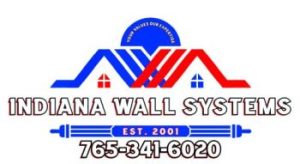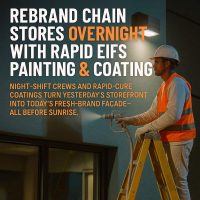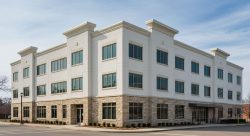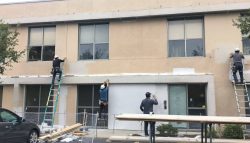How EIFS Enhances Cleanliness, Durability & Efficiency in Healthcare
Hospitals and clinics need clean, strong, and cost-saving building materials. EIFS, or Exterior Insulation and Finishing Systems, offers a smart solution. This blog post will show you how EIFS can make healthcare spaces more hygienic, durable, and efficient.
Read on to learn why EIFS is a top choice for medical buildings.
Key Takeaways
- EIFS helps hospitals stay clean and fight germs. Its smooth surface is easy to clean and resists mold and mildew.
- EIFS saves energy in healthcare buildings. It keeps heat in during winter and out in summer, cutting energy bills.
- EIFS lasts long in busy hospital areas. It can handle bumps from wheelchairs and equipment without breaking.
- EIFS meets strict health rules for hospitals. It helps control infections and works well in cleanrooms.
- EIFS can make old hospitals look and work better. One building cut its greenhouse gas emissions by 94% after adding EIFS.
What is EIFS?
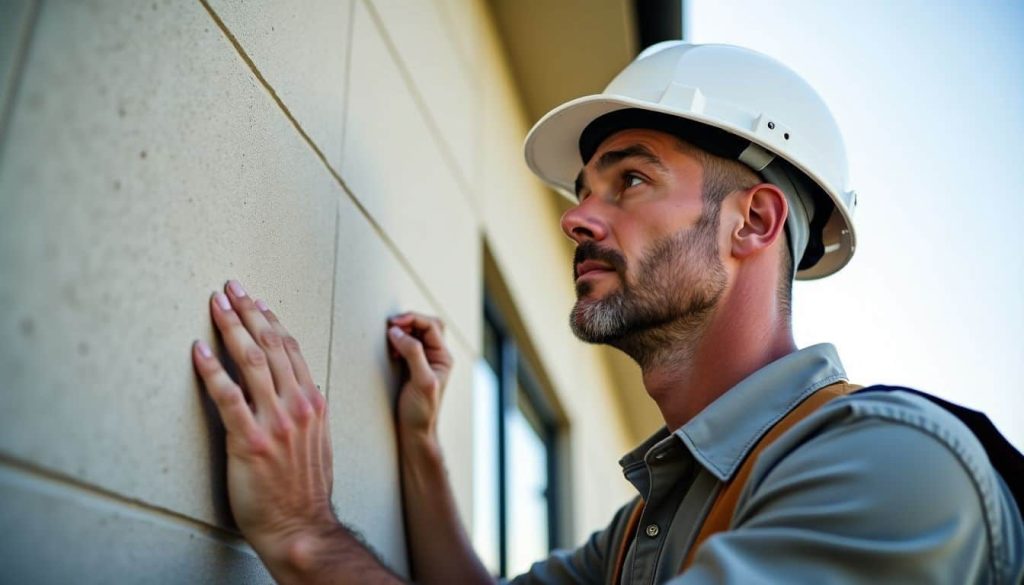
EIFS stands for Exterior Insulation and Finish System. It’s a wall cladding that adds insulation and a decorative finish to buildings.
Definition and Overview
EIFS is a special wall system for buildings. It stands for Exterior Insulation and Finishing Systems. This system covers the outside of a building with insulation and a nice finish.
It’s like a warm coat that keeps the building cozy and looks good too.
EIFS has many parts that work together. There’s a layer of foam insulation to keep heat in. Then, there’s a strong base coat and a mesh for strength. On top, a finish coat gives the wall its final look.
All these parts team up to make buildings more energy-efficient and durable.
EIFS combines insulation and aesthetics to create a high-performance building envelope.
Key Components of EIFS
Now that we know what EIFS is, let’s look at its key parts. EIFS has five main layers that work together to protect buildings. Here’s what makes up an EIFS system:
- Water-resistive barrier: This layer stops moisture from getting in. It’s the first line of defense against water damage.
- Foam insulation board: This can be made of expanded polystyrene, extruded polystyrene, or mineral wool. It helps keep buildings warm or cool.
- Fiberglass mesh: This mesh makes the system stronger. It helps stop cracks from forming.
- Base coat: This layer is water-resistant. It adds extra protection from weather.
- Finish coat: This is the outer layer you see. It looks nice and guards the surface.
- Adhesive: This glue holds the foam board to the wall. It’s a key part of keeping the system in place.
- Substrate: This is what the EIFS attaches to. It could be wood, concrete, or other materials.
- Sealants: These fill gaps and joints. They stop water from getting behind the EIFS.
- Trim: This gives a clean look around windows and doors. It also helps manage water flow.
- Fasteners: These are used with the adhesive to secure the system. They add extra strength.
Why Choose EIFS for Hospitals and Clinics?
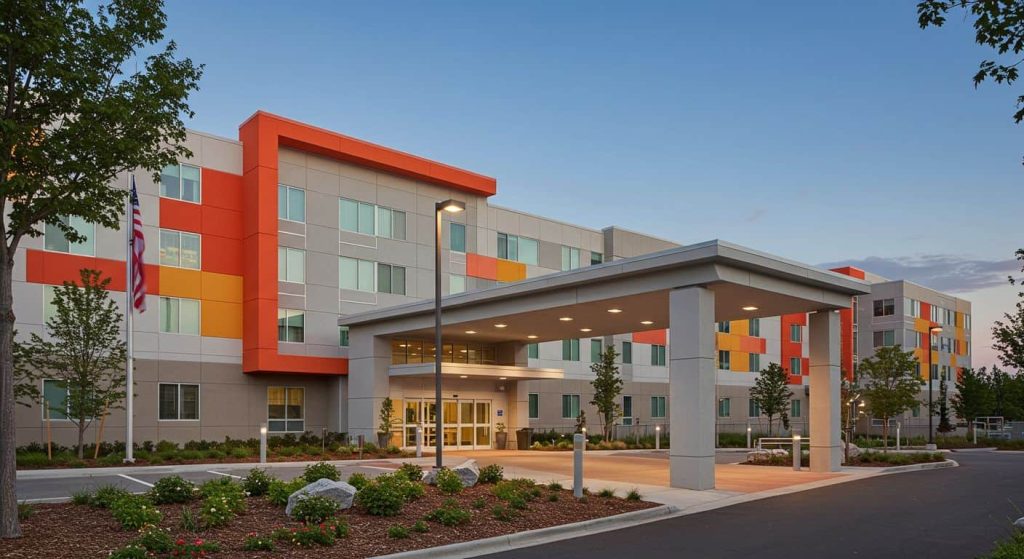
Hospitals and clinics need clean, tough, and smart building systems. EIFS offers a mix of hygiene, strength, and energy savings that fits healthcare needs perfectly.
Importance of Hygienic Materials in Healthcare
Healthcare spaces need clean materials. Germs can spread fast in hospitals and clinics. Clean surfaces help stop this spread. Hygienic materials fight bacteria and mold growth. They also make cleaning easier and more effective.
EIFS offers a hygienic option for healthcare buildings. It resists mold and mildew. Its smooth surface is easy to clean. This helps keep patients safe from infections. EIFS also lasts long, even with frequent cleaning.
A clean environment is the first line of defense against infections in healthcare settings.
The Need for Durable and Efficient Building Systems
Hospitals and clinics need tough, smart building systems. These places see lots of people every day. They must stay clean and work well for years. EIFS offers a great fix. It’s strong and lasts long, even in busy areas.
Plus, it helps save energy. EIFS weighs 80% less than regular stucco but still fights off water. This makes it perfect for healthcare spots that need to stay dry and clean.
EIFS also helps cut costs over time. It keeps heat in during winter and out in summer. This means lower energy bills. The system is easy to clean too. That’s key for keeping germs away in medical spaces.
With EIFS, hospitals can meet strict health rules without breaking the bank.
Hygienic Benefits of EIFS
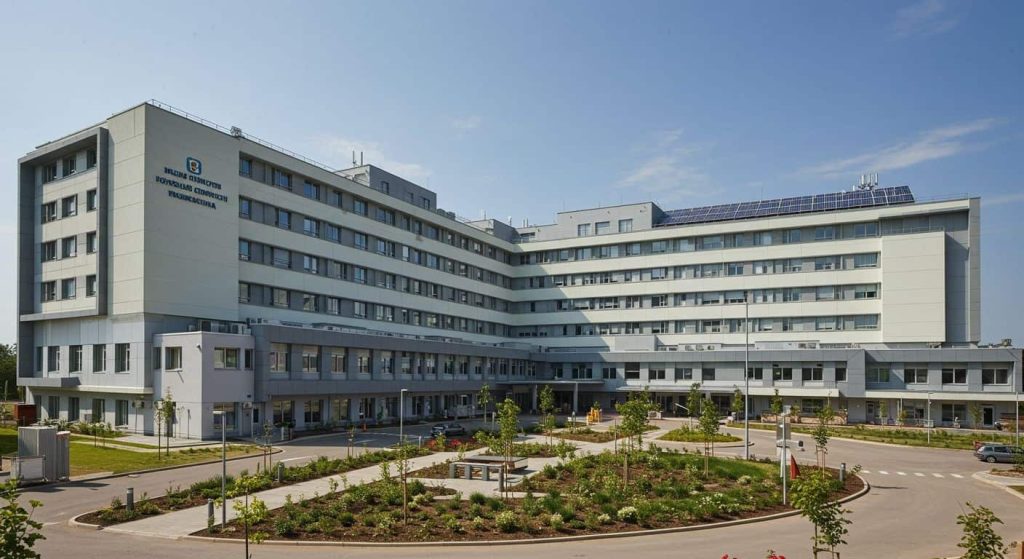
EIFS offers key hygienic perks for hospitals and clinics. Its smooth surface resists germs and makes cleaning a breeze.
Antimicrobial Properties
EIFS coatings can fight germs in hospitals. These special coatings have tiny particles that kill bacteria and other harmful microbes. This helps keep surfaces clean and safe for patients and staff.
The antimicrobial agents work 24/7 to reduce the spread of infections.
Hospitals need extra protection against germs. EIFS with antimicrobial properties offers a smart solution. It creates a barrier that actively fights microbes on walls and other surfaces.
This feature makes EIFS a top choice for healthcare settings where cleanliness is crucial. Next, we’ll look at how EIFS resists mold and mildew growth.
Resistance to Mold and Mildew
EIFS stands up to mold and mildew like a champ. Its water-resistant base coat keeps moisture out, stopping these pesky growths before they start. The system’s smooth surface also makes it hard for spores to take hold.
This means less cleaning and a healthier space for patients and staff. Hospitals and clinics need this kind of protection to meet strict hygiene rules.
Mold resistance is key in healthcare settings. EIFS helps create a clean, safe space that fights off harmful microbes. Its easy-to-clean surface lets staff keep areas spotless with less effort.
This cuts down on time and money spent on upkeep, letting healthcare pros focus on what matters most – patient care.
Easy-to-Clean Surfaces
EIFS systems offer easy-to-clean surfaces that boost cleanliness in hospitals and clinics. These surfaces have textured finishes that don’t trap dirt or germs. Staff can quickly wipe them down to keep areas sterile.
The water-resistant barrier in EIFS also stops moisture from getting in. This helps prevent mold growth and makes cleaning simpler.
Clean surfaces are vital for health care spaces. EIFS meets this need with its smooth, durable exterior. The system’s design cuts down on long-term issues that could affect hygiene.
Stone wool insulation in EIFS adds extra protection. It repels water and doesn’t burn, making it perfect for strict health standards. Next, let’s look at how EIFS stands up to daily wear and tear in busy medical settings.
Durability of EIFS in Healthcare Settings
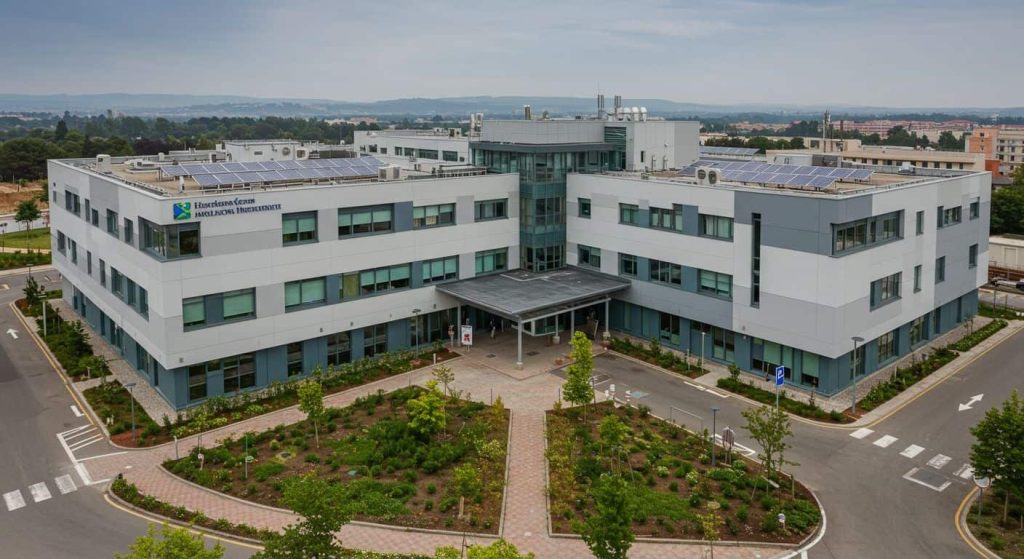
EIFS stands up to the daily wear and tear in busy hospitals. It resists impacts, lasts long in high-traffic areas, and holds up against weather and UV rays.
Impact Resistance
EIFS systems offer strong impact resistance in hospitals and clinics. They use stone wool insulation to boost durability. This helps protect walls from bumps and knocks in busy areas.
The fiberglass mesh adds extra strength too. It stops cracks from forming when the surface gets hit. These features make EIFS a smart choice for high-traffic healthcare spaces.
Tough EIFS walls can handle daily wear and tear. They stand up to wheelchairs, gurneys, and medical equipment. This means less damage and fewer repairs over time. Hospitals and clinics save money on upkeep with EIFS.
The system’s toughness also keeps the building looking good for years.
Long-Lasting Performance in High-Traffic Areas
EIFS stands up well in busy areas of hospitals and clinics. Its tough outer layer resists wear from constant foot traffic and equipment moves. The system’s flexibility helps it absorb impacts without cracking or chipping.
This means less need for repairs and touch-ups over time.
EIFS also keeps looking good for years in high-use spaces. Its smooth finish is easy to clean and doesn’t trap dirt or germs. The color goes all the way through, so small scrapes don’t show.
This helps maintain a fresh, hygienic look even in the busiest hospital hallways or waiting rooms.
Weather and UV Resistance
EIFS stands up to harsh weather and sun damage. Its tough outer layer blocks rain, snow, and wind. The special coating also fights off UV rays that can fade colors. This means hospitals and clinics stay looking good for years.
They don’t need frequent paint jobs or repairs. The durable finish keeps the building safe from cracks and chips too. This saves money on upkeep over time.
Energy Efficiency and Sustainability of EIFS
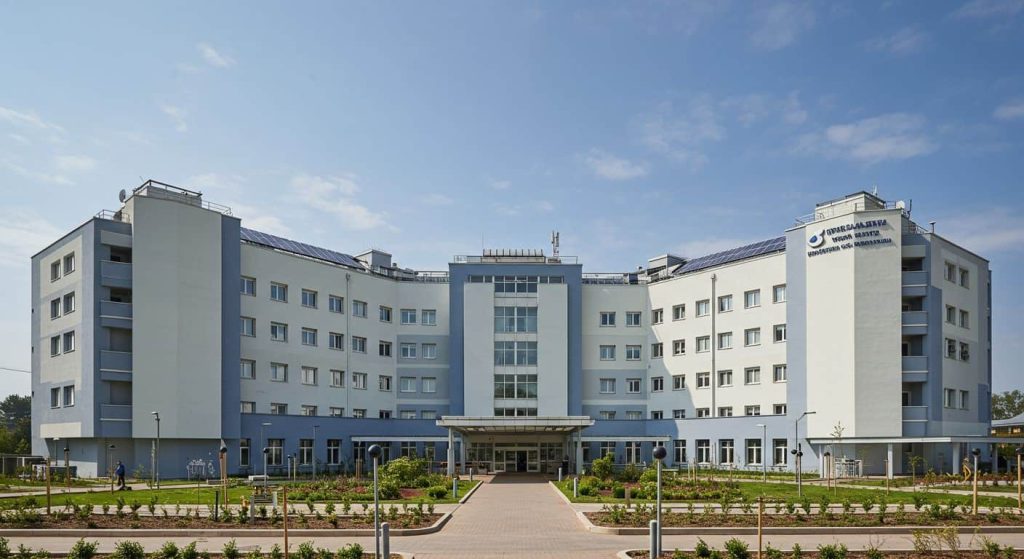
EIFS helps buildings save energy and stay green. It keeps heat in during winter and out during summer. Want to learn more about how EIFS can make hospitals greener? Keep reading!
Thermal Insulation for Energy Savings
EIFS offers top-notch thermal insulation for hospitals and clinics. Its R-values range from 4 to 5.6, which means big energy savings. A national study by Oak Ridge National Laboratory proved this.
From 2005 to 2007, they found that drainage EIFS beat other systems in energy efficiency. This matters a lot for healthcare buildings that run 24/7.
EIFS acts like a warm blanket for buildings. It keeps heat inside during winter and outside during summer. This cuts down on heating and cooling costs. For large hospitals, these savings can be huge over time.
The system also helps maintain steady temps inside, which is key for patient comfort and medical equipment.
Contribution to Green Building Certifications
EIFS helps buildings earn green certifications. It adds points for energy savings and eco-friendly materials. Many hospitals aim for LEED status to show they care about the planet.
EIFS fits right in with these goals. It cuts energy use and greenhouse gases. One project saw a 94% drop in emissions after using EIFS.
Green buildings also boost health. They create better air quality inside. This matters a lot in hospitals where patients need clean air to heal. EIFS plays a key role in making buildings greener and healthier.
Next, let’s look at how EIFS meets strict rules for healthcare buildings.
Reduction in Lifecycle Costs
Green building certifications often lead to lower costs over time. EIFS helps cut these long-term expenses too. It needs less upkeep than other materials. This means fewer repairs and replacements.
EIFS also saves energy, which lowers bills year after year.
EIFS is light, so it puts less stress on a building’s frame. This can make the whole structure last longer. Plus, EIFS resists weather damage well. It doesn’t crack or chip easily.
All these factors add up to big savings for hospitals and clinics over many years.
Compliance with Healthcare Standards
Healthcare facilities must meet strict rules. EIFS systems help hospitals and clinics follow these rules while keeping patients safe.
Meeting Infection Control Requirements
EIFS helps hospitals meet strict infection control rules. Its smooth surface stops germs from growing and is easy to clean. This keeps patients safe from harmful bugs. EIFS also works with special cleaners used in hospitals.
It doesn’t break down or let water in, which could cause mold.
Experts have tested EIFS for use in health care buildings. It meets tough standards set by building codes. EIFS with stone wool insulation is extra strong. This means less damage to walls, which could hide bacteria.
Hospitals can trust EIFS to help them follow infection control guidelines.
Alignment with Cleanroom Standards
EIFS systems can meet strict cleanroom standards in hospitals and clinics. These systems offer smooth, easy-to-clean surfaces that resist mold and bacteria growth. They also help control airflow and dust, which is crucial in sterile areas.
Many EIFS products now come with special coatings that fight germs and make cleaning easier.
Hospitals use EIFS to create spaces that follow cleanroom rules. The smooth finish helps stop dust from settling. It also makes it hard for germs to grow. EIFS can be sealed tightly around doors and windows to keep air clean.
This helps hospitals keep their cleanrooms safe for patients and staff.
Regulatory Compliance in Healthcare Infrastructure
Healthcare buildings must follow strict rules. These rules keep patients safe and healthy. EIFS systems for hospitals and clinics need to meet these standards. They must resist fire, control moisture, and stop germs.
The International Building Code (IBC) says EIFS is okay to use on buildings. But some places have extra rules. For example, New York City wants non-burning materials on tall buildings.
EIFS makers work hard to meet these rules. They test their products to make sure they are safe. This helps hospitals and clinics stay up to code. It also keeps patients protected. The next part will talk about how EIFS looks good and can be changed to fit different needs.
Customization and Aesthetics of EIFS
EIFS offers endless design options for healthcare facilities. Architects can create unique looks that blend with existing structures and boost patient comfort.
Diverse Design Options for Healthcare Facilities
EIFS offers many design choices for hospitals and clinics. Architects can create looks that mimic brick, stone, or stucco. This lets healthcare buildings blend in with their surroundings or stand out.
The finish coats come in countless colors and textures. Designers can mix and match to make unique patterns or logos on walls. These options help make medical spaces more welcoming for patients and staff.
Healthcare facilities need to be clean and easy to maintain. EIFS meets these needs while still looking good. Its smooth surface is simple to wipe down and keeps germs away. At the same time, it can have eye-catching designs that brighten up hallways and waiting rooms.
This mix of function and style makes EIFS a top pick for modern medical buildings.
Integration with Existing Building Structures
EIFS blends well with current buildings. It can cover old walls or add to new ones. This makes it great for updates or new projects. The system fits many shapes and sizes. It works on flat surfaces or curved ones.
Builders like EIFS for its ease of use. They can put it on wood, metal, or concrete. It sticks well to these materials. This helps save time and money on big jobs. EIFS also lets builders fix small flaws in walls.
This makes the final look smooth and even.
Enhancing Patient Comfort through Aesthetic Appeal
EIFS can make hospitals look nice and feel welcoming. This matters because a pretty space can help patients feel better. Colors, textures, and designs from EIFS create a calm setting.
Studies show that nice-looking rooms can lower stress and speed up healing. EIFS lets builders make walls that look good and work well. This mix of style and function is great for healthcare spaces.
Patients often worry in hospitals. But EIFS can help create a space that feels less scary. The smooth walls are easy to clean, which is key for health. They also keep out noise, making rooms more peaceful.
EIFS even helps control temperature, so patients stay comfortable. All these features work together to make a space where people can heal better.
Benefits and Limitations of EIFS in Interior Applications
EIFS offers great benefits for indoor use in hospitals and clinics. It provides a smooth, easy-to-clean surface that helps control germs. The system also adds insulation, which can cut energy costs.
Doctors and patients enjoy the quiet it brings to rooms.
But EIFS has some limits inside buildings, too. It may not stand up well to heavy impacts in busy areas. Water can damage it if not installed correctly. Repairs can be tricky and costly.
Next, we’ll look at why regular checks matter for EIFS systems.
The Importance of Regular EIFS Inspections and Repair
Regular checks of EIFS are vital for hospitals and clinics. These checks stop water from getting in and mold from growing. Quick fixes keep the system working well and saving energy.
They also keep the moisture barrier strong. Good EIFS systems need to be looked at often to make sure they can take hits and stay sealed.
Keeping EIFS clean helps fight germs in healthcare places. Special parts like rockwool need to be checked to last long and work well. Timely repairs keep the building strong and safe.
This helps patients stay healthy and keeps the hospital running smoothly. Next, let’s look at how to take care of EIFS and stucco to manage moisture.
Moisture Management Techniques for EIFS and Stucco Maintenance
EIFS and stucco need good moisture control. Here are key ways to manage moisture and keep these systems in top shape:
- Install proper flashing around windows and doors
- Use high-quality sealants at all joints and seams
- Make sure there’s a good drainage plane behind the EIFS
- Check for and fix any cracks right away
- Clean gutters often to stop water overflow
- Trim plants away from walls to reduce moisture buildup
- Use a water-resistant barrier under the EIFS or stucco
- Install kick-out flashings where roofs meet walls
- Make sure ground slopes away from building walls
- Use breathable finishes that let moisture escape
- Do yearly checks for signs of water damage
- Keep sprinklers aimed away from walls
- Fix leaky pipes or roof issues fast
- Use mold-resistant materials in damp areas
- Install weep screed at the base of walls for drainage
How to Choose the Right EIFS System for Healthcare
Picking the right EIFS system for healthcare is key. You need to match the system to your facility’s needs and rules.
Assessing Facility Needs and Requirements
Hospitals and clinics have unique needs. They must be clean, safe, and energy-smart. EIFS can help meet these needs. It’s vital to look at each facility’s specific wants before choosing an EIFS system.
This includes checking local building codes and fire safety rules. The 2021 International Building Code and NFPA 285 are key guides for EIFS use in healthcare.
A good EIFS plan starts with a full review of the building. Look at things like moisture control, insulation needs, and design wishes. High-quality EIFS offers many options to fit facility standards.
For example, ROCKWOOL insulation in EIFS can boost fire safety and cut noise. These features matter a lot in busy hospitals. Expert advice can help pick the best EIFS for each project.
The next step is to select EIFS with advanced features.
Selecting EIFS with Advanced Features
EIFS with advanced features offer top-notch protection for hospitals. Look for systems like StoTherm CI HI-CM 180, which stands up to hurricanes. Or pick StoTherm CI XPS for great insulation.
These options boost energy savings and keep buildings safe. They also fight mold and germs, which is key in healthcare spaces.
Choose EIFS that meets strict health rules. The right system will be easy to clean and last a long time. It should also help cut energy costs. Ask experts about which EIFS fits your needs best.
They can guide you to pick a system that works well for your specific hospital or clinic.
Working with Experienced EIFS Installers
Skilled EIFS installers are vital for top-notch results. They know the ins and outs of the system and follow maker rules to a T. These pros use the right tools and methods to put EIFS on just right.
They make sure each layer goes on smooth and even. This care stops water from getting in and keeps the building safe.
Good installers also spot issues before they grow. They check for weak spots and fix them fast. Their know-how helps the EIFS last longer and work better. Picking a team with a solid track record is key for any hospital or clinic job.
It’s the best way to get a clean, tough, and efficient outer wall.
Conclusion
EIFS offers a smart choice for hospitals and clinics. It keeps spaces clean, lasts long, and saves energy. This system helps create safe, comfy areas for patients and staff. With EIFS, healthcare buildings can look good and work well for years to come.
It’s a win-win for health, looks, and savings.
FAQs
What is EIFS and why is it good for hospitals?
EIFS, or external insulation and finish system, is a type of siding that’s great for hospitals. It’s like synthetic stucco. EIFS helps keep buildings clean and germ-free. It also saves energy and looks nice. Hospitals need to be clean and safe, and EIFS helps with that.
How does EIFS improve a hospital’s hygiene?
EIFS makes a smooth, sealed surface on walls. This stops germs from growing. It’s easy to clean and doesn’t let water in. This helps keep the air inside clean. EIFS meets high hygiene standards for hospitals. It’s key for infection prevention in medical spaces.
Can EIFS help hospitals save money?
Yes, EIFS can cut costs for hospitals. It insulates well, so it saves on heating and cooling bills. EIFS lasts a long time and needs little upkeep. This means fewer repairs and less spending over time. It’s a smart choice for hospital budgets.
Is EIFS safe to use in hospitals?
EIFS is very safe for hospitals. It’s non-toxic and doesn’t cause allergies. EIFS also resists fire well. It meets strict safety rules for medical buildings. EIFS helps protect patients and staff from harm. It’s a trusted choice for healthcare places.
How does EIFS help with green building for hospitals?
EIFS is great for eco-friendly hospitals. It boosts energy savings with its good insulation. EIFS uses less material than other sidings. This cuts waste. It can help hospitals get LEED certification, too. EIFS fits well with plans for sustainable design in healthcare.
Can EIFS be used on old hospital buildings?
Yes, EIFS works well in old hospitals. It can cover existing walls to make them look new. EIFS adds insulation without big changes to the building. This makes it good for updates. It helps old buildings meet new energy rules. EIFS is a smart way to improve old hospitals.
